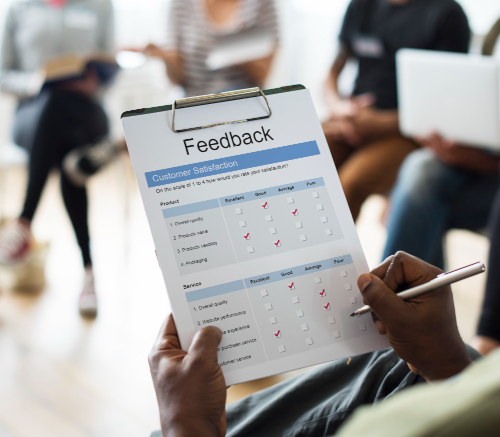Drive Social Media Interactions With Polls and Surveys

In the digital age, social media platforms have become the primary medium for individuals and organizations to foster social media interactions, connecting, sharing, and engaging with their audience in meaningful ways. Polls and surveys have become potent tools within this interactive landscape, offering unique opportunities for enhancing social media interactions beyond traditional likes and comments. This section will delve into the foundational role of these tools in boosting social media interaction, thereby enhancing audience engagement and fostering a dynamic social media presence.
The Importance of Social Media Interactions

Social media interaction stands as a pivotal component of digital strategy for businesses and personal brands alike. It’s not just about broadcasting content but creating a two-way dialogue that enriches the user’s experience and boosts the content’s reach. Through this section, we’ll delve into the mechanics of social media engagement and unveil the multifaceted benefits of cultivating a vibrant, interactive online community.
Understanding Social Media Dynamics
Navigating the currents of social media dynamics demands a nuanced understanding of how interactions shape the landscape of digital engagement. Every like, comment, share, or poll response contributes to a complex algorithmic ecosystem that dictates content visibility and reach. These platforms operate on sophisticated algorithms designed to promote content that generates engagement, creating a feedback loop where highly interactive content gains more exposure. This dynamic underscores the importance of crafting content that resonates with audiences, encouraging them to interact and engage.
Moreover, the dynamics of social media are constantly evolving, with platforms regularly updating their algorithms to prioritize different types of interactions. For instance, recent updates across various platforms have shown a preference for content that fosters meaningful social interactions, such as long-form comments and discussions, over passive interactions like likes. Understanding these shifts is crucial for anyone looking to maintain and grow their presence on social media, making it essential to stay informed about platform updates and adapt content strategies accordingly.
Benefits of Increased Interaction
The benefits of increased social media interaction extend far beyond mere metrics of success; they represent a tangible impact on the ability to reach and engage audiences effectively. Enhanced interaction fosters a deeper connection between content creators and their audience, leading to a more engaged and loyal community.
This connection is invaluable for brands and influencers alike, as it drives brand affinity and can significantly influence consumer behavior. Engaged audiences are more likely to share content within their networks, expanding reach organically and increasing visibility beyond the immediate followers.
Furthermore, increased interaction provides critical insights into audience preferences and behavior, offering real-time feedback on what content resonates most. This feedback loop enables content creators to tailor their offerings more closely to audience desires, improving content relevance and effectiveness.
For businesses, this can translate into improved product development and customer service, as social media interactions offer a direct line to consumer feedback. In essence, fostering high levels of interaction on social media platforms can transform passive viewers into active participants and brand advocates, amplifying the impact of digital marketing efforts and creating a vibrant online community.
Types of Social Interaction on Social Media
Social media platforms host a spectrum of interaction types, each serving a distinct purpose in the ecosystem of digital engagement. From the simple act of liking a post to the direct communication through messages, these interactions form the backbone of social media’s connective power. This segment will categorize and describe the various forms of interactions, emphasizing the unique role of polls and surveys in this context.
Likes, Comments, and Shares

Likes, comments, and shares constitute the foundational elements of interaction on social media platforms, each serving a distinct purpose in the ecosystem of digital engagement. Likes are the simplest form of interaction, allowing users to quickly express appreciation for a piece of content. While seemingly straightforward, likes play a crucial role in algorithmic calculations, signaling popular content that may warrant wider distribution.
Comments offer a deeper level of engagement, providing space for users to share thoughts, feedback, and initiate discussions. This type of interaction is particularly valuable as it not only boosts the visibility of content through algorithmic favor but also fosters a sense of community and dialogue among users. Shares extend the reach of content beyond the original audience, acting as a personal endorsement and significantly amplifying visibility.
The strategic use of likes, comments, and shares can transform the social media presence of a brand or individual. Encouraging users to engage in these interactions requires content that resonates on a personal level, prompts discussion, or is worth sharing within their networks.
Creating such content often involves understanding the audience deeply, including their interests, challenges, and what they value in social media interactions. By focusing on content that naturally encourages these forms of engagement, creators can significantly enhance their social media dynamics, driving more meaningful interactions and expanding their reach.
Direct Messages and Mentions
Direct messages (DMs) and mentions are potent tools for personal engagement on social media, allowing for direct and personalized interaction between users. DMs offer a private channel of communication, making them ideal for in-depth conversations, personalized customer service, or exclusive content sharing.
This direct line to users can be leveraged to build stronger relationships, gather feedback, or offer tailored support, enhancing the overall user experience. Mentions, on the other hand, enable users to tag others in posts or comments, directly drawing their attention to content. This can be a powerful way to increase visibility, engage influencers or peers in relevant conversations, and foster community engagement through direct acknowledgment and interaction.
Utilizing direct messages and mentions effectively requires a nuanced approach. For brands and influencers, this might mean creating opportunities for users to initiate DM conversations, such as through prompts in posts or offering incentives for feedback.
Mentions should be used thoughtfully to engage individuals in relevant discussions or to give credit, avoiding overuse or spammy behavior that could detract from the intended engagement. These tools, when used effectively, can significantly enhance the personal connection between users and brands or influencers, making social media interactions more meaningful and impactful.
Polls and Surveys as Interactive Tools

Polls and surveys emerge as dynamic interactive tools on social media platforms, enabling content creators to engage their audience in unique and meaningful ways. By soliciting direct input from users, these tools not only foster interaction but also provide valuable insights into audience preferences, opinions, and behaviors.
Polls, with their quick and straightforward nature, are excellent for generating instant engagement and gauging public opinion on a variety of topics. They can be used to make content more interactive, gather feedback on products or services, or simply entertain and engage the audience. Surveys, though more detailed, offer depth, allowing for the collection of more comprehensive data that can inform content strategies, product development, and customer service approaches.
The effectiveness of polls and surveys in driving social media engagement hinges on their design and execution. Questions should be crafted to be engaging and relevant to the audience, encouraging participation by sparking interest or curiosity. Timing and placement also play critical roles in maximizing response rates, with strategic posting when the audience is most active leading to higher engagement.
Additionally, the insights gained from these tools can be invaluable in tailoring future content to better meet audience needs, enhancing the overall strategy for social media engagement. When used thoughtfully, polls and surveys can significantly boost interactivity on social media, making them a key component of a successful engagement strategy.
Polls and Surveys: Engaging Your Audience
Polls and surveys represent a direct line to your audience’s thoughts, preferences, and feedback, offering insights that other forms of interaction cannot. This section will highlight how these tools can transform passive observers into active participants, creating a deeper sense of community and involvement among your social media followers.
The Power of Questions
Questions ignite curiosity and invite engagement. They transform viewers from passive consumers of content into active participants. This shift is critical on social media platforms, where engagement can significantly affect visibility and reach.
Asking the right type of question is key. Open-ended questions that prompt reflection or personal input can generate more meaningful interactions. These questions encourage users to share experiences, opinions, and insights, enriching the conversation around your content.
Questions can also serve as a tool for audience research. They reveal what your audience finds interesting, puzzling, or important. This feedback is invaluable for tailoring future content to better match audience interests and increase engagement rates.
Timing and Placement for Maximum Reach
Timing your social media posts is an art. It’s about understanding when your audience is most likely to be online and engaged. Utilizing platform analytics to track engagement trends can pinpoint the best times for posting. This strategy ensures your content has the best chance of being seen and interacted with.
Placement is equally important. Different platforms cater to different content formats and audiences. For example, stories may perform better on Instagram, while detailed posts might see more engagement on Facebook. Leveraging these differences can enhance the visibility and impact of your content.
Furthermore, experimenting with content placement across various sections of a platform can reveal where your audience prefers to interact with your content. Whether it’s a feed, story, or a specialized group, finding the right spot can significantly boost your content’s performance.
Crafting Effective Polls and Surveys
The effectiveness of polls and surveys in driving engagement hinges on their design and execution. From the phrasing of questions to the visual appeal of the survey, each element plays a crucial role in attracting and retaining the audience’s attention. We will explore the key factors that contribute to creating compelling polls and surveys that not only engage but also provide valuable insights.
Question Design
Crafting questions for social media requires thoughtful consideration of the audience’s interests and the type of engagement you wish to foster. The design of a question can dramatically influence the quantity and quality of responses. A well-posed question should be clear, concise, and crafted to spark interest or provoke thought. It’s not just about what you ask but how you ask it. The wording should invite participation, making it easy for the audience to engage.
To encourage a broad spectrum of responses, questions should be open-ended and relevant to the audience’s experiences and interests. Incorporating trending topics, common challenges, or universal experiences can increase the relatability of the question, encouraging more users to engage.
Open vs. Closed Questions
Open and closed questions serve different purposes in social media engagement. Open questions, which cannot be answered with a simple “yes” or “no,” encourage more detailed responses. They invite sharing of thoughts, experiences, and detailed feedback, fostering deeper engagement. Closed questions, on the other hand, are useful for gathering specific information or conducting quick polls. They can be effective in encouraging participation from users who might be reluctant to type out longer responses, offering a way to engage with minimal effort.
Choosing between open and closed questions depends on the goal of the interaction. If the aim is to start a conversation or gather nuanced insights, open questions are more suitable. For quick engagements or when seeking specific information, closed questions can be more effective.
Visuals and Interactivity
In the visually-driven world of social media, incorporating visuals into questions can significantly enhance their appeal and engagement potential. Visuals catch the eye, making questions stand out in a crowded feed. They can also convey complex ideas quickly and effectively, providing context that words alone might not achieve. When paired with interactive elements like polls or sliders, visuals can transform a simple question into an engaging experience.
The use of visuals encourages users to stop and interact with content, increasing the time spent on a post. This, in turn, signals to social media algorithms that the content is engaging, potentially boosting its reach. The key is to use high-quality, relevant images or videos that complement the question and resonate with the audience.
Incorporating Media
Incorporating media, such as images, videos, and GIFs, into questions not only makes them more engaging but also enhances the user’s experience. Media can illustrate concepts, evoke emotions, and prompt reactions in ways that text alone cannot. For example, a question about a recent event paired with a compelling image can spark a stronger reaction and encourage more comments and shares.
The choice of media should be intentional, reflecting the tone and content of the question. It should add value, either by providing information, setting a mood, or illustrating a point, ensuring that the media enhances rather than distracts from the question being asked.
Ensuring Accessibility
Accessibility should be a key consideration when designing questions and interactive content for social media. Ensuring that all users, regardless of ability, can engage with your content is not just inclusive but expands your reach. This includes using clear, concise language and providing alternative text descriptions for visual media. Captioning videos and using screen-reader-friendly formats allows users with visual or hearing impairments to participate fully.
Interactive features like polls should be designed with accessibility in mind, ensuring that they can be navigated and used with assistive technologies. Keeping accessibility at the forefront of question design not only broadens your audience but fosters an inclusive online community.
Analyzing Responses to Enhance Social Interaction
Beyond mere numbers, the responses to polls and surveys offer a goldmine of qualitative insights into your audience’s preferences and behaviors. This section will discuss how to analyze this data effectively, turning raw responses into actionable strategies that enhance future social interactions and content planning.
Interpreting Data

Interpreting the data gathered from social media interactions, especially from polls and surveys, provides a wealth of information about your audience’s preferences, behaviors, and opinions. This process involves analyzing response patterns, feedback, and engagement levels to uncover actionable insights. It’s not just about quantifying the responses but understanding the sentiment and context behind them. For instance, high engagement with a particular question or topic might indicate a strong interest or concern among your audience, suggesting areas for deeper exploration or content development.
Additionally, demographic and psychographic information gleaned from interactions can help tailor content more effectively to different segments of your audience. Tools and platforms offering analytics capabilities can aid in this analysis, allowing for a more nuanced understanding of how different content performs across various audience groups. This data-driven approach enables creators and brands to refine their messaging, timing, and content formats to better align with audience expectations and interests.
Leveraging Insights for Content Strategy
The insights obtained from analyzing social media data are invaluable for informing your content strategy. Understanding what resonates with your audience can guide the creation of content that is more likely to engage and inspire. This might mean focusing on specific topics that have generated significant interest, adopting tones or formats that have seen higher engagement, or even identifying the best times to post for maximum interaction.
Furthermore, insights from data can highlight gaps in your content strategy or opportunities for innovation. Perhaps your audience shows a keen interest in topics you’ve yet to explore, or they engage more with interactive content types like quizzes and polls.
Acting on these insights means not only meeting your audience’s current needs but also anticipating their future interests, keeping your content strategy dynamic and responsive. This approach ensures a sustained engagement, fostering a loyal community around your brand or persona on social media.
Best Practices for Maximizing Engagement Through Polls and Surveys
To maximize the impact of polls and surveys, it’s crucial to adhere to a set of best practices while also avoiding common pitfalls. This segment will offer a comprehensive guide to optimizing these tools for engagement, drawing on expert advice and industry standards to help readers build more interactive and responsive social media campaigns.
Do’s and Don’ts
When leveraging polls and surveys for social media engagement, it’s crucial to adhere to certain best practices while avoiding common pitfalls.
Do ensure your questions are clear, concise, and relevant to your audience’s interests to encourage participation. Incorporate a variety of question types to keep engagement high and provide valuable insights from different angles. Do respect your audience’s privacy by not asking for sensitive or personal information that might make them uncomfortable.
On the flip side, don’t overload your audience with too many polls or surveys, as this can lead to survey fatigue, reducing the quality and quantity of responses over time. Don’t ignore the feedback received; acknowledging and acting on your audience’s input demonstrates that you value their opinions, fostering a stronger connection and loyalty.
Another essential do is to analyze and share the outcomes of polls and surveys with your audience where appropriate. This transparency can increase trust and interest in future interactions. However, don’t make every interaction about gathering data. Balance is key in maintaining an engaging, interactive social media presence that feels genuine rather than transactional. Remember, the goal is to enhance engagement and provide value to both you and your audience through these interactive tools.
Continuous Improvement
The landscape of social media is ever-evolving, with audience preferences and platform algorithms constantly changing. This dynamic environment necessitates a mindset of continuous improvement in your engagement strategies, including the use of polls and surveys. Regularly reviewing the performance of your interactive content, coupled with ongoing audience feedback, can reveal insights into what’s working well and what could be improved. Experimenting with different types of questions, formats, and timing can help identify the most effective strategies for engaging your audience.
Incorporating a feedback loop into your strategy is crucial for continuous improvement. Actively seeking and listening to audience feedback about your polls and surveys not only helps refine your approach but also deepens audience engagement by making them feel heard and valued. This process of iteration, based on data and feedback, ensures your social media presence remains vibrant, relevant, and engaging over time, adapting to the shifting landscapes of both audience preferences and platform capabilities.
Wrapping Up
As we wrap up the discussion, it’s clear that polls and surveys stand out as powerful mechanisms for fostering social media interaction. This concluding section will recap the major insights and strategies outlined throughout the article, reinforcing the importance of these tools in building a more engaged and connected online community.

